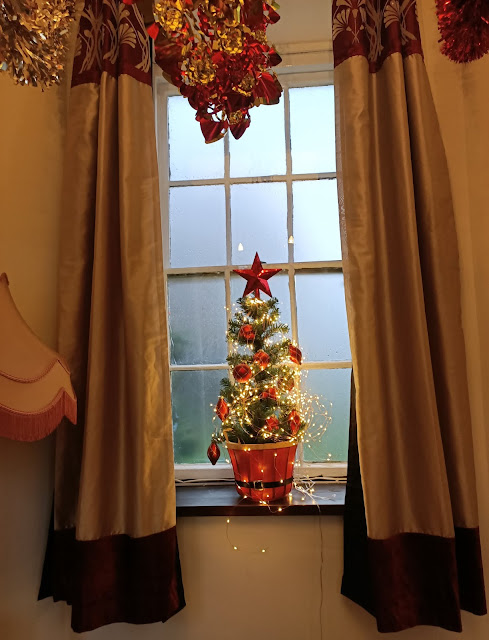A Thread from the Past
Whilst the temperatures have been cooler this week at Betley Court Gardens, spring is definitely on its way. The daffodils are slowly turning the edges of the paths and woodland golden yellow. Our grey squirrel population are keeping us amused as they charge around overhead on the branches, filled with desire and looking for love. It won’t be long before we’re joined by a flurry of baby squirrels!
 |
| A host of golden daffodils at Betley Court Gardens. |
Steven, our work experience lad from Reaseheath College has spent a second week helping out, and we’ve been busy cutting back overhanging branches, snipping and deadheading, planting seeds and potting up. He's been a great help around the gardens! The students from the arboriculture course return soon, as Reaseheath College begins class-based teaching again – and our woodland is their outdoor classroom for this term.
 |
| Steven, secateurs at the ready! |
Up over Betley Court, our scaffolders have safely installed another three sections of the temporary roof sheeting. I’m intrigued to find out how a roof covering changes the atmosphere inside the house, which has been an outside/inside experience since the fire destroyed the roof in 2019.
 |
| Our scaffolding mega-structure, as seen from Court Walk |
An interesting thread popped up this week, on the Betley Local History Society Facebook page. It was prompted by an image from a postcard from 1938 posted by Laura Watkin from the Staffordshire Past Track photographic archive. It shows the Wilderness, the avenue of lime trees that run along Main Road between Betley Court and Betley Court Farm.
 |
| The Wilderness, an avenue of lime trees along Main Road, Betley c. 1938 |
Rhoda Farrington, a great local historian mentioned that the last Squire, Captain Charles Fletcher-Twemlow, had stopped fox hunting on the Betley Court estate shortly after he inherited it. By coincidence, I’d come across this very story, through the pages of a newspaper article from 1936. Astonishingly, the fact that a country squire from the Midlands decided to ban hunting on his land made the regional papers across England.
In 1936, Captain Charles Royds inherited Betley Court from his great-uncle, the old Squire, with one condition that we know of; he should change his surname to Fletcher-Twemlow. He inherited a country house, a farm and 1,500 acres of land, so we can assume it wasn’t too much of a dilemma for him.
 |
| The North Staffordshire Hunt on the Main Road outside Betley Court |
The old Squire, George Fletcher-Twemlow was an enthusiastic supporter of the North Staffordshire Hunt, as was his wife. They enjoyed country pursuits, as illustrated by the magnificence of their horse stables, complete with clock tower, built to the north of Betley Court.
 |
| The palacial horse accomodation, the stables at Betley Court |
The old Squire was delighted to let the Hunt use the 1,500 acres of the Betley Court estate, which was, according to the article, “of exceptionally good hunting country to the hounds.”. Its fair to say that the North Staffordshire Hunt presumed the cordial arrangement would continue after the Squire’s death. The letter from Captain Charles Fletcher-Twemlow following his interitence of Betlye Court, must have come as a bolt out of the blue. Miss RH Harrison, the Master of the hunt received the letter in August 1936, explaining that “for reasons of conscience he does not wish the hunt in future to hunt over his land” according to the article.
The news was greeted with dismay by the North Staffordshire hunting community, and immediately, the hunt committee sprang into action, asking Captain Fletcher-Twemlow to reconsider. The Captain stood by his decision. The hunt secretary, Mr W Jones, declined to comment on the ban, “but said it would be great pity if old traditions such as the association of the hunt with the Betley Court estate were broken.”
 |
| Nottingham Journal, 21 Aug 1936 |
I can’t begin to imagine what shock waves this news sent
around the district. Country landowners held such sway and influence over those
around them, and the decision clearly marked a dramatic change in how the
squire viewed his relationship with his staff, the wider village population,
and with other wealthy landowners in the area. The fact that he lived ‘down
south’ at the time the letter was written was mentioned not once, but twice in
the article, and I don’t doubt that the decision of a distant squire rankled enormously.
Bigger societal changes were on the horizon anyway, as the
threat of another war loomed. Betley Court was requestioned for the war effort,
becoming an orthopaedic unit for injured servicemen. And like many country
houses, the estate was broken up and sold off piece by piece by the late 20th
century.
Captain Charles Fletcher Twemlow’s name, however lives on at Betley Court, at least, his original surname. When Professor and Dr Brown bought Betley Court from the Captain’s widow, they suggested naming one of the new apartments they was creating after her late husband. She simply requested that they use her husband’s real name. Royd’s House is there today, proudly looking out across the south lawn, one of the three apartments that survived the fire.
 |
| Royd's House today, sticking out of the scaffolding sheath. |
All best wishes
Ladybird Su



Comments
Post a Comment